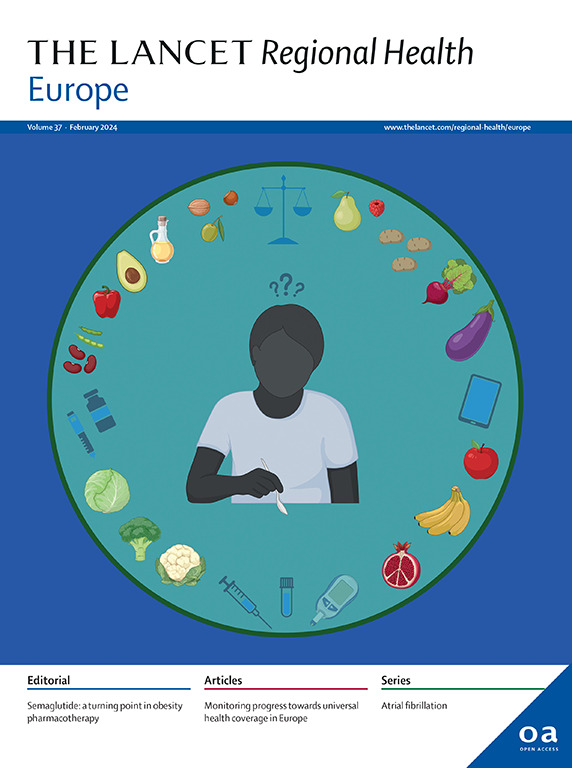肝内胆管癌的发病率、治疗和生存的社会经济差异:来自瑞典全国队列研究的见解
IF 13
Q1 HEALTH CARE SCIENCES & SERVICES
引用次数: 0
摘要
背景肝内胆管癌(iCCA)的发病率在全球范围内呈上升趋势,但社会经济地位(SES)在全民医疗保健系统中形成疾病负担和护理方面的作用仍然知之甚少。本研究评估了瑞典iCCA在发病率、治疗和生存方面与ses相关的差异。方法使用国家登记数据,确定2011年至2021年诊断的所有成人iCCA病例(n = 1827)。来自瑞典肝癌质量登记的数据与社会经济和保健登记交叉关联。家庭收入——分为低(最低的全国四分位数)、中或高(最高的四分位数)——被用作SES指标。对不同收入阶层的发病率、治疗模式和生存率进行了分析。年龄标准化IR从2011年的1.35 / 10万人年增加到2021年的1.94 / 10万人年,其中男性和低收入人群的增幅最大。与高收入人群相比,低收入人群在所有阶段(1.32,95%可信区间[CI]: 1.15-1.52)和晚期iCCA (1.46, 95% CI: 1.17-1.81)的IR比更高。可预防的肝脏疾病在低收入人群中更为普遍,而原发性硬化性胆管炎和炎症性肠病在高收入人群中更为常见。低收入患者接受全身治疗的几率较低(调整后的优势比0.54,95% CI: 0.38-0.77),接受治疗的患者死亡风险较高(调整后的风险比1.34,95% CI: 1.09-1.65)。尽管全民享有医疗保健,但在瑞典,iCCA的发病率、治疗和结果仍然存在巨大的社会经济差异。资助瑞典癌症协会和瑞典皇家科学院。本文章由计算机程序翻译,如有差异,请以英文原文为准。
Socioeconomic disparities in incidence, treatment, and survival of intrahepatic cholangiocarcinoma: insights from a nationwide cohort study in Sweden
Background
The incidence of intrahepatic cholangiocarcinoma (iCCA) is rising globally, yet the role of socioeconomic status (SES) in shaping disease burden and care within universal healthcare systems remains poorly understood. This study assessed SES-related disparities in the incidence, treatment, and survival of iCCA in Sweden.
Methods
National registry data were used to identify all adult cases of iCCA diagnosed from 2011 to 2021 (n = 1827). Data from the Swedish quality register for liver cancer were cross-linked with socioeconomic and healthcare registers. Household income– categorised as low (lowest national quartile), medium, or high (highest quartile)–was used as the SES indicator. Incidence rates (IRs), treatment patterns, and survival were analysed across income strata.
Findings
The age-standardized IR increased from 1.35 in 2011 to 1.94 per 100,000 person-years in 2021, with the steepest rise observed among men and individuals with low income. Compared to those with high-income, individuals with low income had higher IR ratios of all-stage (1.32, 95% confidence interval [CI]: 1.15–1.52) and late-stage iCCA (1.46, 95% CI: 1.17–1.81). Preventable liver diseases were more prevalent in the low-income patients, while primary sclerosing cholangitis and inflammatory bowel disease were more common among high-income patients. Low income was associated with lower odds of receiving systemic therapy (adjusted odds ratio 0.54, 95% CI: 0.38–0.77) and higher mortality risk among those treated (adjusted hazard ratio 1.34, 95% CI: 1.09–1.65).
Interpretation
Despite universal healthcare access, substantial socioeconomic disparities persist in the incidence, treatment, and outcomes of iCCA in Sweden.
Funding
The Swedish Cancer Society and The Royal Swedish Academy of Sciences.
求助全文
通过发布文献求助,成功后即可免费获取论文全文。
去求助
来源期刊

Lancet Regional Health-Europe
Multiple-
CiteScore
19.90
自引率
1.40%
发文量
260
审稿时长
9 weeks
期刊介绍:
The Lancet Regional Health – Europe, a gold open access journal, is part of The Lancet's global effort to promote healthcare quality and accessibility worldwide. It focuses on advancing clinical practice and health policy in the European region to enhance health outcomes. The journal publishes high-quality original research advocating changes in clinical practice and health policy. It also includes reviews, commentaries, and opinion pieces on regional health topics, such as infection and disease prevention, healthy aging, and reducing health disparities.
 求助内容:
求助内容: 应助结果提醒方式:
应助结果提醒方式:


